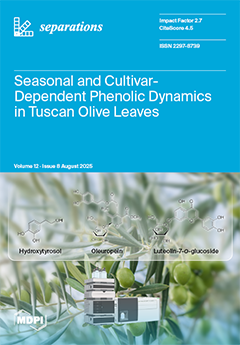Aimed at developing an economical and efficient biosorbent for the adsorption and separation of rare earth ions, this study employed Spirulina dry powder biomass as a biosorbent to investigate its removal performance for Pr
3+ in aqueous solutions. Experimental results demonstrated that under optimized conditions (pH = 5, adsorbent dosage = 2.0 g/L, initial Pr
3+ concentration = 100 mg/L, and adsorption time = 60 min), the removal efficiency of Pr
3+ reached 79.0%. FT-IR and XPS characterization confirmed the participation of various functional groups on the Spirulina surface in the adsorption process. When 0.1 mol/L HNO
3 was used as the desorption agent, the desorption rate of Pr
3+ from Spirulina reached 91.7%, demonstrating excellent regeneration performance. At different temperatures (298–318 K), the adsorption data were fitted using Langmuir, Freundlich, Dubinin–Radushkevich, and Redlich–Peterson models. Among them, the Langmuir model (
R2 ranged from 0.993 to 0.999) provided the best fit, and the adsorption capacity of Spirulina for Pr
3+ was in the range of 51.10 to 55.31 mg/g. Kinetic studies revealed that the pseudo-second-order model (
R2 = 0.999) best described the adsorption process, with a rate constant of 0.054 g/(mg·min) (
R2 was 0.999) at an initial Pr
3+ concentration of 300 mg/L, indicating chemisorption-controlled behavior. Thermodynamic parameter analysis showed that within the experimental temperature range,
ΔG0 < 0 and
ΔS0 > 0, confirming that the adsorption process was spontaneous and endothermic. This study provides a novel technical approach for the green recovery of rare earth elements and highlights the potential of Spirulina biomass in rare earth resource recycling.
Full article





